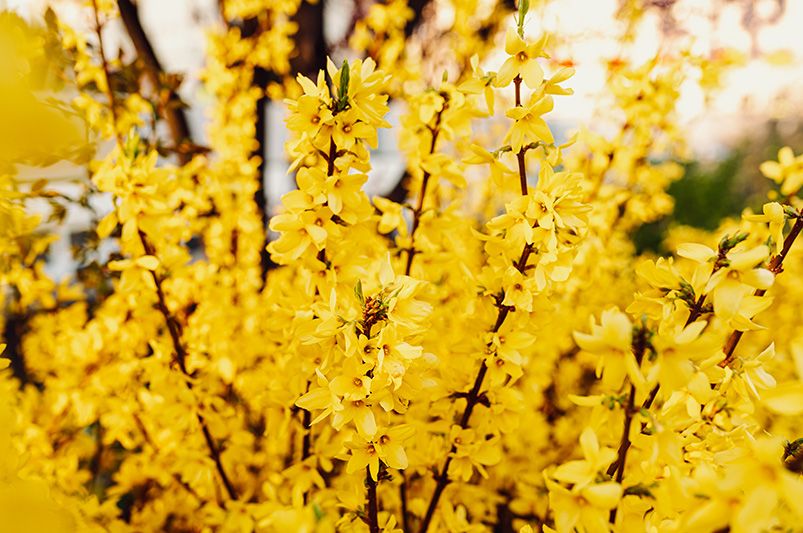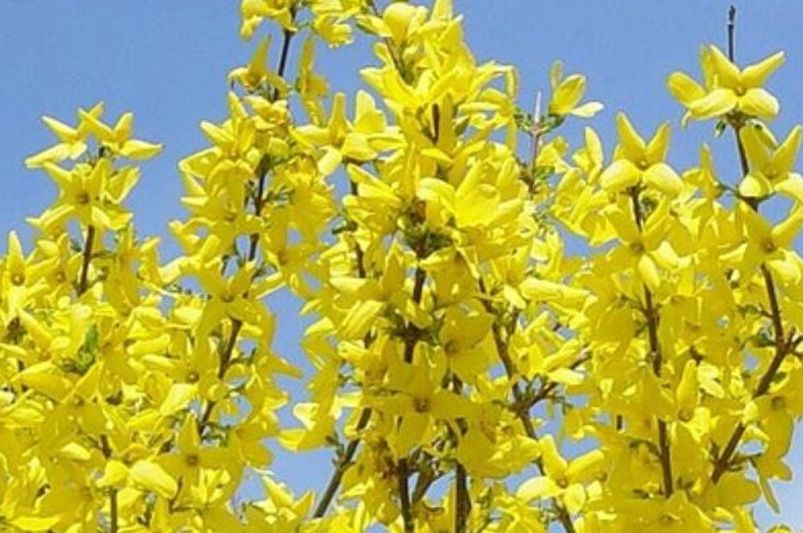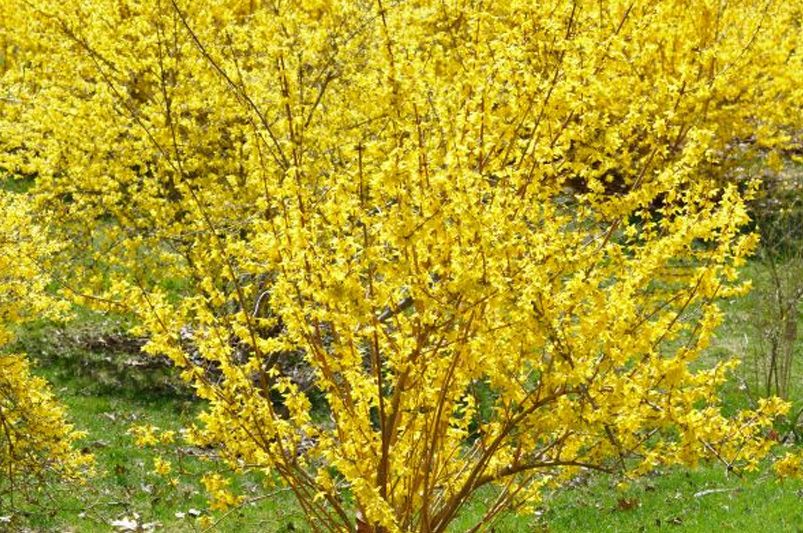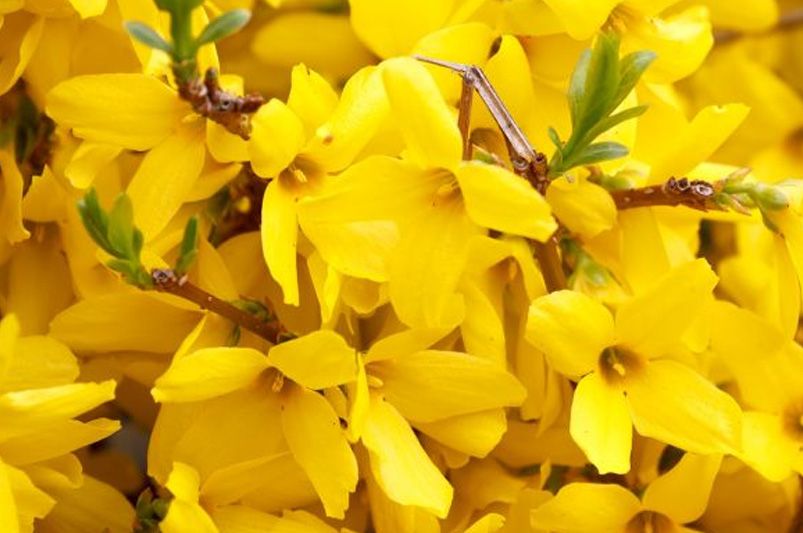
Forsythia: Essential Tips for Growing Healthy Plants
Published: 08/07/2025 | Updated: 08/07/2025
Key Highlights
-
Forsythia bushes are known for their brilliant yellow flowers, which herald the onset of early spring with a vibrant display.


-
Thriving in full sun, this deciduous shrub is versatile in a variety of gardens, including borders and cottage settings.
-
Forsythia flowers bloom along the entire length of the stems, creating an eye-catching spectacle.
-
The plant is a rapid grower and requires minimal maintenance, ideal for gardeners of all skill levels.
-
Popular varieties, like Forsythia x intermedia and Lynwood Gold, provide options tailored to different climates and spaces.
Let’s dive into what makes this shrub so beloved worldwide.
Introduction
Forsythia is one of the first signs of early spring in North America. It shows off bright yellow blooms that usually appear before the leaves come out. You can see it shining across gardens when most other plants are not awake yet. This easy-care shrub grows well in many climates and works with different gardening styles. People like forsythia because of how good it looks and how simple it is to grow. It is a good and steady pick for any garden.
Understanding Forsythia and Its Appeal
Forsythia is a good pick for any garden. This deciduous shrub stands out because it gives a burst of color with its brilliant yellow flowers in early spring. Varieties like forsythia x intermedia and forsythia suspensa show their yellow flowers when most other plants are not yet blooming after winter. Forsythia grows fast, so it can fit well in many places, like small urban yards and cottage gardens. This shrub does more than look nice. It helps with erosion control and gives a home for insects that are good for the garden. That is why it is great for anyone who wants to help garden biodiversity.
Key Characteristics of Forsythia
Known for its bright yellow flowers, forsythia is a deciduous shrub that stands out in early spring. The branches fill up with brilliant yellow blooms even before the leaves start to show. This marks a clear change from winter to spring. Types like forsythia x intermedia and forsythia suspensa do well in many kinds of soil, as long as there is good drainage. These strong plants do more than just look good. They help with erosion control, too. For this reason, people like to plant them in cottage gardens and along shrub borders.

Popular Forsythia Varieties for U.S. Gardens
Forsythia has many types, so you can find the right one for what you need, like size or when it blooms. Look at the table below to compare them:
|
Variety Name |
Height/Spread |
Special Features |
|---|---|---|
|
Forsythia x intermedia |
6-9 feet tall |
Lots of flowers, works great for hedges |
|
6-9 feet tall |
Many blooms, stands out in spring gardens |
|
|
Northern Gold |
6-8 feet tall |
Very good with cold, can bloom down to -30°F |
|
Forsythia suspensa |
6-10 feet tall |
Has weeping, soft stems; works well on slopes |
|
Kumson |
4-6 feet tall |
Has special leaves with silver veins |
These forsythia x types show that there is a good forsythia plant for every kind of garden or climate. If you want to use forsythia x intermedia, forsythia suspensa, northern gold, or lynwood gold, you will find one that fits your space.

Best Conditions for Planting Forsythia
Forsythia grows well when you give it the right mix of good soil, lots of sunlight, and a nice spot. This plant can live in partial shade, but it does much better in full sun. In full sun, it will have more flowers. You should use well-draining soil and mix in organic matter. This helps the roots stay healthy and strong.
If you want to grow Forsythia as a bright hedge, for a nice foundation planting, or in a shrub border, it is important to pick the right place. A good spot will help the plant look its best every year. Now, let’s talk about the best soil and places for growing Forsythia.
Ideal Soil Types and pH Levels
Forsythia grows best in soil that lets water drain well but still keeps some moisture. Using soil with lots of organic matter helps hold just the right amount of water so the roots are healthy and don’t get root rot. A mix with loam is great for this, but adding some sand can help water drain out better. The best soil for Forsythia has a pH between 6.0 and 7.5. This helps the plant grow strong and gives it lots of yellow flowers in early spring. The right acidity in the soil also helps the plant get all the nutrients it needs. It’s a good idea to test the soil often. This way, you will see those bold yellow flowers and know your plant is healthy. Getting the soil ready in the right way will help your Forsythia be strong every year.
Choosing the Right Location and Sunlight Exposure
Choosing the right place to plant forsythia helps it grow well. This plant likes full sun best. When you put it in a spot that gets a lot of sun, these shrubs show off their brilliant yellow flowers in early spring. If forsythia grows in partial shade, it can still do well, but it will not have as many yellow flowers. Enough sunlight helps keep fungal diseases away. It helps the shrub be strong and healthy. You should think about where buildings or other things are so the plant gets at least six hours of sun every day. This will make your forsythia bloom bright yellow flowers and stand out early in spring.

Step-by-Step Guide to Planting Forsythia
Picking the right time and getting ready are both important when you want to grow forsythia. Start by making sure the place you want to plant it in has soil that drains well and has plenty of organic matter. This will help the roots grow strong. Dig a hole big enough for the root ball. Set the plant in the hole so that the top of the root ball is at the same level as the dirt around it.
Water the new plants well right after you plant them. Keep an eye on the soil moisture, especially when there are dry spells. Putting mulch around your plant is a good way to keep moisture in and stop weeds from growing. This gives your new plants the best chance to do well.
When to Plant for Optimal Growth
... the rest goes on. It keeps talking about "when" and "planting spaces techniques".
Proper Spacing and Planting Techniques
Spacing is important when you plant forsythia. It lets air move between the plants and helps sunlight get to every part. Keep each shrub 3 to 10 feet apart. The distance may change based on the type you have.
Put the plants with the top of the root ball level with the soil, not lower. This will help stop root rot. Use soil that drains well and has lots of organic matter. This kind of soil helps the forsythia grow strong.
During the growing season, add mulch on top. Mulch helps keep in soil moisture and keeps weeds down. This makes it a good place for your forsythia and their yellow blooms.

Forsythia Care Essentials
Taking care of forsythia plants is the way to get bright blooms and strong growth. You need to water them often, mostly in dry spells. Try not to use overhead watering, because it can lead to fungal diseases. It is a good idea to put mulch around to help keep soil moisture in. Mulch can also keep out weeds and add organic matter to the ground.
Make sure you use fertilizer at the right step of the growing season. Go for slow-release types so they give food to the plant over time. Look at the base of the plant often. Watch out for any signs of root rot. Check the drainage holes now and then so roots stay healthy. Good drainage will stop waterlogging and help the forsythia plants to grow well.
Watering and Mulching Tips
Making sure the soil has enough moisture is important to help forsythia plants grow strong. During dry spells, water deeply at the base. This helps the root ball be healthy and stops root rot. Try to keep the soil regularly damp, especially in the first growing season for your forsythia shrub.
Lay mulch around the base to hold in water and block weeds, which protects new growth. Using organic matter like bark or straw keeps soil pH steady. It also gives more nutrients to the plants. All of this helps your forsythia plants have better new growth and bright yellow blooms.
Fertilizing and Soil Amendments
Fertilizing forsythia plants is important if you want to get bright yellow flowers and healthy new growth. Use a fertilizer that has the same amount of nitrogen, phosphorus, and potassium. This helps the plants grow strong, especially in early spring when there is new growth. Adding some organic matter to the soil is good too. It helps the ground drain water better and hold just the right amount of water, which can stop root rot. You should also check the soil's pH. Try to keep it between 6.0 and 7.0. Putting compost on the soil once a year gives your forsythia plants more of the things they need. This helps them stay strong, with more nutrients and good microbes.
Pruning and Maintaining Healthy Forsythia
Effective pruning is important to keep forsythia plants healthy. It also helps with new growth and stops the plants from getting too big. The best time to do this is in late winter or early spring, before forsythia blooms open. Cut away old wood and remove any branches that are not healthy. This will make the plants strong and ready for the season. When you shape the shrubs, you help them keep a nice look and make space for brilliant yellow flowers to grow. Check the plants often for pests, like the Japanese weevil and spider mites. Doing this protects them from harm and gives you bright yellow flowers every year.
How and When to Prune Forsythia
Pruning is important for keeping forsythia shrubs healthy and strong. This deciduous shrub grows well from late winter to early spring, just before the new growth starts. You should focus on cutting away old wood to help new flower buds grow. Doing this helps the shrub make brighter yellow blooms during the growing season. Cut back about one-third of the older stems all the way to the base. This will help with good air flow. Do not use overhead watering at this time. Too much water on the leaves can lead to fungal diseases.
Managing Overgrowth and Shaping Bushes
Keeping forsythia shrubs in good shape helps them look nice and stay healthy. The best time to prune them is in late winter, before you see any new growth. Make sure you cut away old wood or any that is dead. This will help the shrubs bloom better in spring. If you see dense branches, trim some out. This lets more light and air get in to the plant. Doing this can help stop fungal diseases and make the flowers better. Try to give the shrub a balanced look but do not put too much stress on it. That way, it will grow well.
Conclusion
In short, growing forsythia brings a burst of color to your garden. You will see its brilliant yellow flowers appear in early spring. This deciduous shrub stands out when it blooms. To help it do well, you need to know the way it grows and follow some simple care steps. These include watering it the right way, using mulch, and cutting it back as needed. If you keep up with these tasks, you can make sure it grows strong and looks great.
Forsythia is also a vigorous grower. You can use it as an eye-catching foundation planting and as a good way to help with erosion control in your yard or garden. It has many uses and does well in lots of places, adding life and bright color wherever you plant it.
Frequently Asked Questions
Is Forsythia deer resistant?
Forsythia is not deer resistant. In fact, deer often like to eat its soft leaves. To keep your plants safe, you can use fencing or try natural sprays that keep deer away. This will help stop deer from eating these bright shrubs in the spring.
How fast does Forsythia grow and spread?
Forsythia can grow about 1 or 2 feet each year. In time, it will stand between 3 feet and 10 feet tall, depending on which type you have. These plants spread out a lot as they grow. That makes them a good option if you want to have thick hedges or borders in your yard. Forsythia also gives you bright flowers during spring, so your garden will look nice.
What pests or diseases affect Forsythia?
Forsythia can have problems with pests like aphids and spider mites. It can also get diseases, such as powdery mildew and crown rot. You should check your plants often and take care of them well. This will help you keep these problems away. It makes the plants grow strong and gives them bright flowers.
Can I grow Forsythia in containers?
Yes, forsythia can grow well in containers if the container is big enough for their roots. Make sure you use a potting mix that lets water flow out well, and pick a container with drainage holes. You need to water and feed the plant often so it can stay healthy in a small space.
Why isn’t my Forsythia blooming?
Many things can change when forsythia blooms. It may not get enough sunlight. You might cut it back the wrong way. It can also have low nutrients. Sometimes, harsh weather or bugs cause stress to the plant, which can stop the flowers from coming out. Make sure you give your forsythia the care it needs. This will help it get healthy and have lots of nice blooms in the spring.


